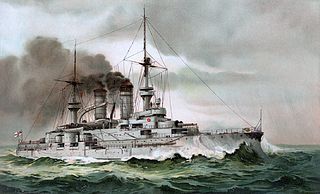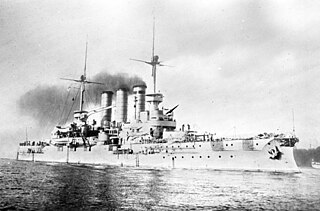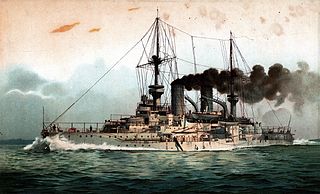Deutschland is the German-language word, or endonym, for Germany.
Contents
Deutschland may also refer to:
Deutschland is the German-language word, or endonym, for Germany.
Deutschland may also refer to:
The Kriegsmarine was the navy of Germany from 1935 to 1945. It superseded the Imperial German Navy of the German Empire (1871–1918) and the inter-war Reichsmarine (1919–1935) of the Weimar Republic. The Kriegsmarine was one of three official branches, along with the Heer and the Luftwaffe, of the Wehrmacht, the German armed forces from 1935 to 1945.
Hermann Bauer was a German naval officer who served as commander of the U-boat forces of the Kaiserliche Marine during World War I. In addition to his World War I career, Bauer is well known as the author of the book Das Unterseeboot, a treatise on the design and operation of U-boats, which was later translated into English by Hyman G. Rickover. Rickover's translation became a basic text for the US submarine service.
Aktien-Gesellschaft Vulcan Stettin was a German shipbuilding and locomotive building company. Founded in 1851, it was located near the former eastern German city of Stettin, today Polish Szczecin. Because of the limited facilities in Stettin, in 1907 an additional yard was built in Hamburg. The now named Vulcan-Werke Hamburg und Stettin Actiengesellschaft constructed some of the most famous civilian German ships and it played a significant role in both World Wars, building warships for the Kaiserliche Marine and the Kriegsmarine later.

The Deutschland class was a series of three Panzerschiffe, a form of heavily armed cruiser, built by the Reichsmarine officially in accordance with restrictions imposed by the Treaty of Versailles. The ships of the class, Deutschland, Admiral Scheer, and Admiral Graf Spee, were all stated to displace 10,000 long tons (10,160 t) in accordance with the Treaty, though they actually displaced 10,600 to 12,340 long tons at standard displacement. The design for the ships incorporated several radical innovations, including the first major use of welding in a warship and all-diesel propulsion. Due to their heavy armament of six 28 cm (11 in) guns and lighter weight, the British began referring to the vessels as "pocket battleships". The Deutschland-class ships were initially classified as Panzerschiffe, but the Kriegsmarine reclassified them as heavy cruisers in February 1940.

Deutschland (A59) was a naval ship of the Bundesmarine, the West German Navy. She was constructed and used as a training cruiser ("Schulschiff") in peacetime and planned for multi-role missions in the event of war: troop ship, hospital ship, minelayer, and escort. In order to prepare cadets in the best possible way for their duties in the active fleet, the ship was carrying the type of armament and machinery that was reflecting the equipment fitted to the German Navy ships of that period. Therefore, the machinery was rather diverse, and performance-wise the emphasis had rather been laid on range than speed. Under deck, comparably large teaching rooms underlined the primary role and, unlike other ships in the fleet, Deutschland had some civilians serving alongside military personnel.

SMS Nassau was the first dreadnought battleship built for the Imperial German Navy, a response to the launching of the British battleship HMS Dreadnought. Nassau was laid down on 22 July 1907 at the Kaiserliche Werft in Wilhelmshaven, and launched less than a year later on 7 March 1908, approximately 25 months after Dreadnought. She was the lead ship of her class of four battleships, which included Posen, Rheinland, and Westfalen.

SMS Zähringen was the third Wittelsbach-class pre-dreadnought battleship of the German Imperial Navy. Laid down in 1899 at the Germaniawerft shipyard in Kiel, she was launched on 12 June 1901 and commissioned on 25 October 1902. Her sisters were Wittelsbach, Wettin, Schwaben and Mecklenburg; they were the first capital ships built under the Navy Law of 1898, brought about by Admiral Alfred von Tirpitz. The ship, named for the former royal House of Zähringen, was armed with a main battery of four 24 cm (9.4 in) guns and had a top speed of 18 knots.

SMS Deutschland was the second and final ship of the Kaiser-class ironclads; SMS Kaiser was her sister ship. Named for Germany, the ship was laid down in the Samuda Brothers shipyard in London in 1872. The ship was launched in September 1874 and commissioned into the German fleet in July 1875. Deutschland mounted a main battery of eight 26 cm (10.2 in) guns in a central battery amidships. She was the last capital ship built for the German Navy by a foreign ship-builder; all subsequent ships were built in Germany.
Heligoland is a German island in the North Sea.

SMS Hansa was a protected cruiser of the Victoria Louise class, built for the German Imperial Navy in the 1890s, along with her sister ships Victoria Louise, Hertha, Vineta, and Freya. Hansa was laid down at the AG Vulcan shipyard in Stettin in 1896, launched in March 1898, and commissioned into the Navy in April 1899. The ship was armed with a battery of two 21 cm guns and eight 15 cm guns and had a top speed of 19 knots.

Kaiserliche Werft Kiel was a German shipbuilding company founded in 1867, first as Königliche Werft Kiel but renamed in 1871, with the proclamation of the German Empire. Together with Kaiserliche Werft Danzig and Kaiserliche Werft Wilhelmshaven it was one of three shipyards which produced warships for the Preußische Marine and later the Kaiserliche Marine. With the end of World War I Kaiserliche Werft Kiel was closed but the shipyard was opened again when Deutsche Werke was founded on their grounds in 1925.

Kaiserliche Werft Wilhelmshaven was a German shipbuilding company in Wilhelmshaven, founded in 1871 and closed in 1918. Together with Kaiserliche Werft Danzig and Kaiserliche Werft Kiel it was one of three shipyards which solely produced warships for the Preußische Marine and the following German Kaiserliche Marine. With the end of World War I all three imperial shipyards were closed, but the Wilhelmshaven shipyard was reopened in 1919, first as Reichsmarinewerft Wilhelmshaven, and after 1935 named Kriegsmarinewerft Wilhelmshaven.

SMS Braunschweig was the first of five pre-dreadnought battleships of the Braunschweig class built for the German Kaiserliche Marine. She was laid down in October 1901, launched in December 1902, and commissioned in October 1904. She was named after the Duchy of Brunswick. The ship was armed with a battery of four 28 cm (11 in) guns and had a top speed of 18 knots. Like all other pre-dreadnoughts built at the turn of the century, Braunschweig was quickly made obsolete by the launching of the revolutionary HMS Dreadnought in 1906; as a result, her career as a front-line battleship was cut short.

SMS Mecklenburg was the fifth ship of the Wittelsbach class of pre-dreadnought battleships of the German Imperial Navy. Laid down in May 1900 at the AG Vulcan shipyard in Stettin, Germany, she was finished in May 1903. Her sister ships were Wittelsbach, Zähringen, Wettin, and Schwaben; they were the first capital ships built under the Navy Law of 1898, championed by Admiral Alfred von Tirpitz. Mecklenburg was armed with a main battery of four 24-centimeter (9.4 in) guns and had a top speed of 18 knots.
SMS Deutschland may refer to one of the following ships in the German Empire's Kaiserliche Marine:

SMS Gefion was an unprotected cruiser of the German Kaiserliche Marine, the last ship of the type built in Germany. She was laid down in March 1892, launched in March 1893, and completed in June 1895 after lengthy trials and repairs. The cruiser was named after the earlier sail frigate Gefion, which had been named for the goddess Gefjon of Norse mythology. Intended for service in the German colonial empire and as a fleet scout, Gefion was armed with a main battery of ten 10.5-centimeter (4.1 in) guns, had a top speed in excess of 19.5 knots, and could steam for 3,500 nautical miles, the longest range of any German warship at the time. Nevertheless, the conflicting requirements necessary for a fleet scout and an overseas cruiser produced an unsuccessful design, and Gefion was rapidly replaced in both roles by the newer Gazelle class of light cruisers.

SMS Augsburg was a Kolberg-class light cruiser of the German Kaiserliche Marine during the First World War. She had three sister ships, SMS Kolberg, Mainz, and Cöln. The ship was built by the Kaiserliche Werft in Kiel; her hull was laid down in 1908 and she was launched in July 1909. Augsburg was commissioned into the High Seas Fleet in October 1910. She was armed with a main battery of twelve 10.5 cm SK L/45 guns and had a top speed of 25.5 knots.